3.9 Chorioptic Mange – Large Animals
Learning Objectives
- Learn the season that chorioptic mange occurs more often.
- Describe the lesions and their distribution in bovine, caprine, ovine, and equine with chorioptic mange.
- Learn how the disease is transmitted.
- Learn how to diagnose chorioptic mange.
- Learn how to manage chorioptic mange.
-
General Considerations
- Chorioptic mange is also named “Leg Mange”, “Tail Mange”, “Foot Mange”.
- It is a common parasitic skin disorder of cattle, goats, sheep, and horses.
- Mites are surface-inhabiting parasites that feed on epidermal debris.
- The life cycle takes about 2 to 3 weeks and is completed on the host.
- It is generally stated that the mites only live a few days off the host. However, Chorioptes bovis has been shown to survive up to 69 days outside the host.
- Transmission is by direct and indirect contact.
- Interspecies transmission seems rare.
- Mite populations are usually much larger during cold weather. Thus, the disease is usually seen or is more severe in the winter.
- Chorioptic mange is not a zoonotic disease.
-
Bovine Chorioptic Mange
- Cause:
- Chorioptes bovis
- Clinical Signs:
- It is the most commonly diagnosed mange in cattle.
- It is most evident in the winter in stabled cattle, particularly dairy animals in Northeastern U.S.
- Intense pruritus, erythema, papules, self-inflicted alopecia, exudation, crusts, and ulceration are characteristic clinical signs.
- Lesions are generally confined to the perineum, back of the udder, and rear legs.
- Cause:
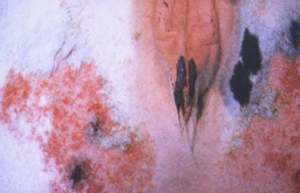
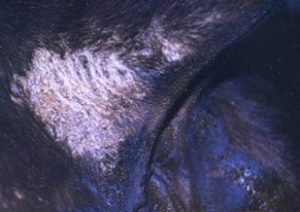

-
-
- A rare syndrome characterized by coronitis, intense irritation, and a marked decrease in milk production can be seen.
- Lesions disappear in the summer and return in the winter.
- In summer months, mites persist on the skin above the hooves and can be found on skin scrapings in the absence of clinical signs.
- It can be difficult to eradicate the mites.
-
-
- Diagnosis:
- History and clinical signs.
- Multiple skin scrapings. Mites are easily found on skin scrapings (mites are fast moving).
- Treatment:
- Treat all in contact animals.
- 0.03% coumaphos or 0.25% crotoxyphos (twice, at a 10 to 14- day interval) or 2% lime sulfur (weekly for 4 weeks).
- A report showed that doramectin pour-on applied once at the dose of 0.5mg/kg (1ml/10kg) was more than 99% effective against Chorioptes bovis infestation by day 14 or 15 after treatment.
- Diagnosis:
-
Caprine Chorioptic Mange
- Cause:
- Chorioptes caprae
- Clinical Signs:
- Fairly common in stabled goats during the winter in the Northeastern U.S..
- Pruritus is typically intense.
- Lesions include erythema, papules, self-inflicted alopecia, excoriation, exudation, and crusts. Similar to the disease in cattle, lesions are most commonly seen on the hindquarters.
- Cause:
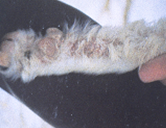
-
- Diagnosis:
- History and clinical signs.
- Skin scrapings. Mites are easily found on skin scrapings (mites are usually fast-moving).
- Treatment:
- All in contact animals should be treated.
- 0.25% crotoxyphos, 0.25% coumaphos, and 0.2% trichlorfon. Total body dips or sprays at least twice at a 10- to 14- day interval.
- 2% lime sulfur dip or spray, weekly for 4 weeks. It is safe in lactating goats.
- Diagnosis:
-
Ovine Chorioptic Mange
- Cause:
- Chorioptes bovis var. ovis
- Clinical Signs:
- Pruritus is typically severe.
- One or more of the following lesions can occur: erythema, papules, self-inflicted alopecia, excoriations, exudation, crusts, and ulceration.
- The lower parts of the hind limbs and scrotum are typically affected.
- Foot stamping can occur due to intense pruritus and severe inflammation.
- Rams can become temporarily infertile owing to the presence of scrotal dermatitis caused by the mites.
- It is eradicated in the U.S.; therefore, it is reportable.
- Cause:
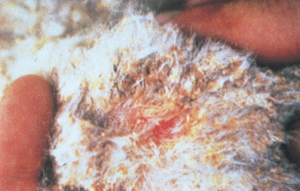
-
- Diagnosis:
- History and clinical signs.
- Skin scrapings. Multiple skin scrapings. Fast moving mites are easily found on skin scrapings.
- Treatment:
- State-approved acaricidal treatments and quarantine procedures should be employed.
- Diagnosis:
-
Equine Chorioptic Mange
- Cause:
- Chorioptes equi or Chorioptes bovis.
- Cause:
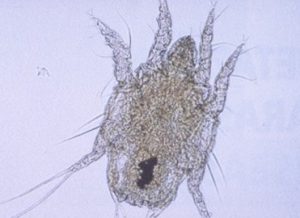
-
- Clinical Signs:
- Chorioptic mange is considered the most common mange of horses.
- It is not zoonotic.
- The mite life cycle is 2-3 weeks and mites can live off host for a few days.
- Clinical signs include severe pruritus manifested by foot stamping and chewing at legs, self-inflicted alopecia, erythema, excoriation and crusts.
- Clinical Signs:

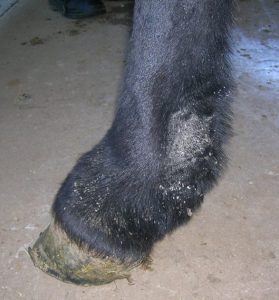
-
-
- Fetlocks, pasterns, and tail are body sites particularly affected.
- Exudative, proliferative dermatitis with secondary bacterial infection (‘greasy heels’) may develop in severe cases.
- Infestations are most commonly seen in draft horses and other horses with feathered fetlocks, especially during the winter. Be aware that chorioptic mange can be a secondary problem of draft horses with chronic progressive lymphedema.
-
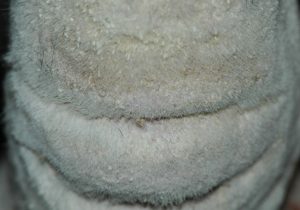
-
- Diagnosis:
- History and clinical signs.
- Demonstrate the mite in scrapings from fresh lesions, they can be often found on the edges of more chronically affected skin.
- Differential diagnoses include other causes of pastern dermatitis (staphylococcal folliculitis, allergic or irritant contact dermatitis, photosensitization, dermatophytosis, dermatophilosis, vasculitis) and tail rubbing (insect hypersensitivity, food allergy, lice, oxyuriasis, stable vice).
- Treatment:
- Treat all in contact animals. Ideally clip the “feathers” of draft horses and shampoo affected areas before applying the parasiticides (e.g. benzoyl peroxide or 1% selenium sulfide shampoos).
- Ivermectin at the dose of 200 µg/kg (0.2 mg/kg) orally, four treatments at 2-week intervals.
- Moxidectin: 2% oral gel at 0.4 mg/kg administered orally once.
- Fipronil spray 0.25% applied every 2 weeks to affected areas for four to six treatments. Make sure to dampen the skin and coat for effectiveness. It can be an expensive therapy if large or multiple areas are affected.
- Doramectin at 0.3 mg/kg administered subcutaneously four times 14-day intervals.
- 5% lime sulfur solution applied once every 7 days for four treatments have shown good results.
- Selenium sulfide 1% solution applied three times at 5-day intervals has shown to be efficacious.
- Prevention and Control:
- As mites can be spread by direct or indirect contact, care should be taken to avoid sharing brushes, combs, tack, or other objects between affected and non-affected animals.
- Affected animals should be separated from those that appear to have no active signs of the disease.
- Insecticide application (e.g., pyrethrins, carbamates) to tack and grooming equipment, stalls, and lounging areas may be of value in reducing re-infestation of recently treated animals, and disease dissemination.
- Treat all horses that cohabit pastures, barns, or working areas. Some horses with few or no clinical signs may harbor chorioptic mites and serve as carriers.
- Diagnosis:
Important Facts
- Chorioptic mange is a very pruritic condition seen more often during winter.
- The disease often spontaneously regresses during summer as mite numbers become very small.
- The seasonality of mite population and clinical signs is thought to be influenced by temperature, humidity and wetting of the host.
- Lesions are most often seen on hindquarters including the udder, perineum, scrotum, legs and tail.
- It is reportable in sheep in the U.S.
- Mites are easily found on multiple skin scrapings.
- Lime sulfur, coumaphos, crotoxyphos, ivermectin, fipronil, selenium sulfide and doramectin are typically effective.
- Treat all in-contact animals.
References
Kondratjeva J, Combarros D, Pressanti C et al. What is the most effective treatment in horses with chorioptic mange? Equine Vet Educ 2022; DOI: 10.1111/eve.13637
Lloyd DH, Littlewood J, Craig M, et al. Pruritus. In:Practical equine dermatology. Oxford, Blackwell Science, 2003; 11-12.
Pugh DG, Hu XP, Bourke KH. Control of chorioptic mange mites on horses, donkeys, and mules. Alabama Cooperative Extension System 2013; ANR-1444.
Rendle DI, Cottle HJ, Love S et al. Comparative study of doramectin and fipronil in the treatment of equine chorioptic mange. Vet Rec 2007; 161:335-38.
Rooney KA, Illyes EF, Sunderland SJ et al. Efficacy of a pour-on formulation of doramectin against lice, mites, and grubs of cattle. Am J Vet Res 1999; 60(4): 402-404.
Scott DW. Parasitic Diseases. In: Large Animal Dermatology. Philadelphia, PA: W.B. Saunders, 1988; 222-225.
Sweatman GK. Life history, nonspecificity, and revision of the genus Chorioptes, a parasitic mite of herbivores. Can J Zool 1957; 35:641-689.

